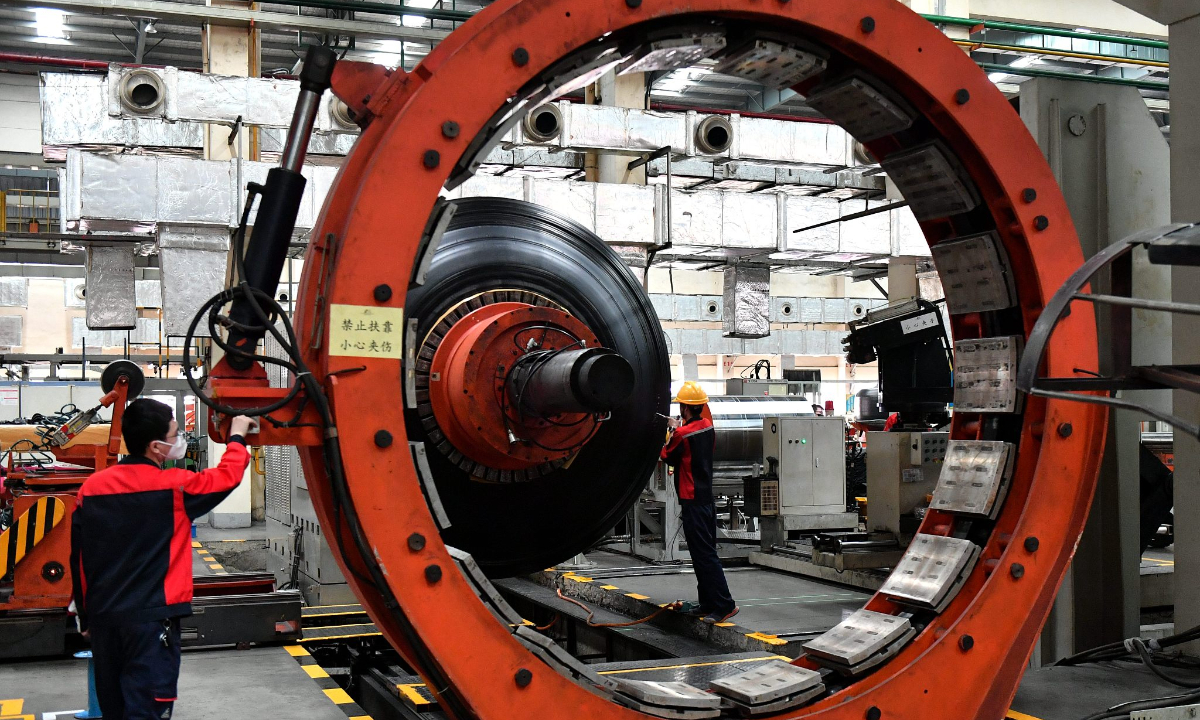China's private Caixin Manufacturing PMI up to 50.9 in February
Manufacturing companies show improved post-Chinese New Year outlook: NBS

PMI Photo:VCG
China's private Caixin Manufacturing Purchasing Managers' Index (PMI) recorded a month-on-month expansion in February, pointing to robust business activities among small and private enterprises. The official manufacturing PMI, also released on Friday, indicated a better production outlook following the Chinese New Year holidays.
As the first major economic barometer in February, the PMI showed that the proactive measures taken by the government have taken effect and indicates an overall improvement in the Chinese economy at the start of the year, experts said.
China's private Caixin Manufacturing PMI reached 50.9 in February, up from 50.8 in January, standing in expansion territory for four consecutive months. Caixin PMI largely reflects business activity of privately run small and medium-size enterprises in China.
In February, the manufacturing production index, new orders index, and new export orders index expanded by 0.1 to 0.3 points, remaining within expansion range, with the new export orders index reaching a new high in a year. Manufacturing entrepreneurs are feeling more optimistic as production and operation expectations index hit a new high since May 2023, according to the private survey.
The Caixin Manufacturing PMI has been above the expansion line for four consecutive months, the first time since the second half of 2021, indicating an overall improvement in the economy and solid progress in high-quality development, said Wang Zhe, Senior Economist at Caixin Insight Group in a notice on Friday.
The official manufacturing PMI, released by the National Bureau of Statistics (NBS), came in at 49.1 on Friday, slightly lower from 49.2 in January.
Due to the impact of the Spring Festival holidays, manufacturing production activities have slowed down. However, businesses' expectations remain stable, showing their increased confidence in market development after the Spring Festival, Zhao Qinghe, an NBS statistician said in a notice on Friday.
The manufacturing industry production expectation index for February came in at 54.2, an increase of 0.2 points from the previous month, according to NBS, indicating increased confidence after the Spring Festival holidays.
Experts said that reports by some foreign media hyping China's PMI data showing consecutive manufacturing drops are ignoring objective factors.
"As the Chinese New Year holidays fell in February this year, the PMI data for the month is likely to be heavily influenced by seasonal factors and the impact of the holiday on manufacturing activities, raw material procurement, distribution, and recruitment," Zhou Maohua, an economist from China Everbright Bank, told the Global Times on Friday.
February's manufacturing PMI met expectations and the service sector even outperformed them, reflecting a better and more optimistic overall economic recovery than the market anticipated, Zhou said.
Driven by seasonal demand, the official non-manufacturing PMI reached 51.4 in February, up 0.7 points from the previous month. The service industry activity index came in at 51.0 in February, up 0.9 points from the previous month.
The rapid expansion of non-manufacturing PMI in February is consistent with the surging tourism market and transportation data during the Spring Festival holidays.
The holidays saw 474 million domestic tourist trips, up 34.3 percent year-on-year, and travel spending reaching 632.687 billion yuan ($88.89 billion), up 47.3 percent year-on-year, according to the Ministry of Culture and Tourism.
The composite PMI, a weighted average of manufacturing and service PMI, came in at 50.9, remaining unchanged from the previous month, which shows that the overall Chinese economy is maintaining an expansionary trend.
"As macroeconomic measures are put in place to stimulate domestic demand, we can expect to see improvements in both manufacturing and service sector PMI indices in the coming months," Zhou said.
Chinese authorities have implemented a series of policies at a rapid pace to boost economic growth.
The efforts include issuing 1 trillion yuan in special bonds in the fourth quarter of 2023, cutting the five-year-plus loan prime rate (LPR) more than expected by 25 basis points, reducing the reserve requirement ratio (RRR) to inject 1 trillion yuan into the market, and supporting the real estate sector with a new whitelist mechanism.
As long as the policies can be implemented proactively and provide sufficient support during the recovery phase, the economy will see a pretty good performance in the first quarter, Tian Yun, an economist based in Beijing told the Global Times on Friday.
China has allocated all the funds raised from the issuance of an additional 1 trillion yuan of government bonds for post-disaster rebuilding and disaster prevention projects, China's top economic planner said on February 7, in a major boost for infrastructure investment and related economic activity.
A slew of data in February also shows that the Chinese economy is stabilizing and improving.
As of February 24, a total of 25,000 job fairs had been held nationwide, with 16 million job positions posted, as work resumption and the return of migrant workers are contributing to an early start to work after the Spring Festival, according to the Ministry of Human Resources and Social Security.
Since February, multiple regions have been pushing for economic growth and are entering the busiest time of the year for production.
Groundbreaking ceremonies for major projects had been held in nearly 10 provinces as of February 26, with an increase in private investments. For example, East China's Zhejiang Province recently held project kickoff events with 87 industrial projects led by private enterprises, totaling 181.3 billion yuan in investment, accounting for nearly half of the total investment.

